Kidding In Goats
Kidding, the act of the birthing process in goats, shown in Figures 8-1, 8-2 and 8-3, is the culmination of the breeding process in goats. Kidding represents the finale of the approximately 150-day gestation period in the breeding doe.

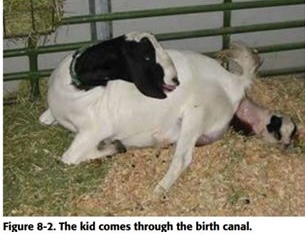
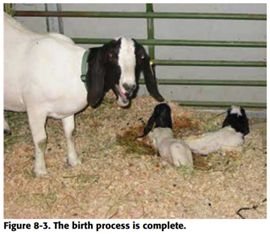
Kidding
Close to the end of the gestation period, grazing the pregnant does nearby helps producers easily check on them. Any supplement of concentrate or hay should be fed to the does at night. Late feeding can delay birthing to the early morning hours in the majority of animals. Have some kidding pens ready for weak kids or reluctant mothers. Prekidding signs in goats are not always easy to detect; however, mucous discharge is a sure sign that kidding is close.
Kidding Process
There are three stages of the kidding process. Stage one is the preparatory stage. During this stage, the kid should rotate into the upright position and the cervix will start to dilate. The doe will become restless as her uterus starts to contract. This stage can last between four to eight hours with mature does and six to 12 hours with doe kids (first time mothers).
Stage two is the delivery stage. The water sac will appear first as the kid enters the birth canal. The water sac will then rupture and the front feet and head should appear. Then the kid is delivered. This stage should take less than one hour for mature does, but can take up to four hours for doe kids.
Stage three is the cleaning stage. The doe’s straining decreases as the attachment between the uterus and placenta relaxes and separates. The placenta then is expelled from the doe. The placenta is commonly referred to as the afterbirth. This stage can last from one to eight hours.
All three stages should take place with little to no assistance from the producer, although sometimes it is necessary to lend assistance. Generally this assistance will be during stage two of the kidding process. Determination of when assistance is needed is sometimes difficult and usually requires close observation.

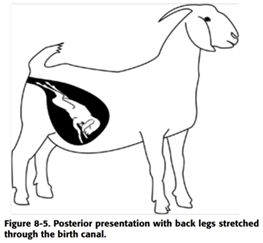
Normal Births
In goats, the kids can be delivered in two normal presentations. Figure 8-4 shows the anterior presentation. The kid’s head is first with the front legs extended out of the birth canal. A majority of births occur this way. Unless the kid is too big for the birth canal, no assistance should be needed. Figure 8-5 shows the posterior presentation with the hind legs extended through the birth canal and the back end coming first. This is normal and a doe should be able to have the kid with no assistance. It is when the presentation is not normal that assistance may be needed.
Abnormal Presentations
If a doe begins stage two of the kidding process and the kid or kids are not positioned in a normal presentation the doe could have difficulty giving birth. Figure 8-6 shows some of the abnormal ways a kid can be positioned. If a kid is positioned abnormally, it must be repositioned to a normal presentation before it can be delivered. This requires assistance from the producer or a veterinarian.
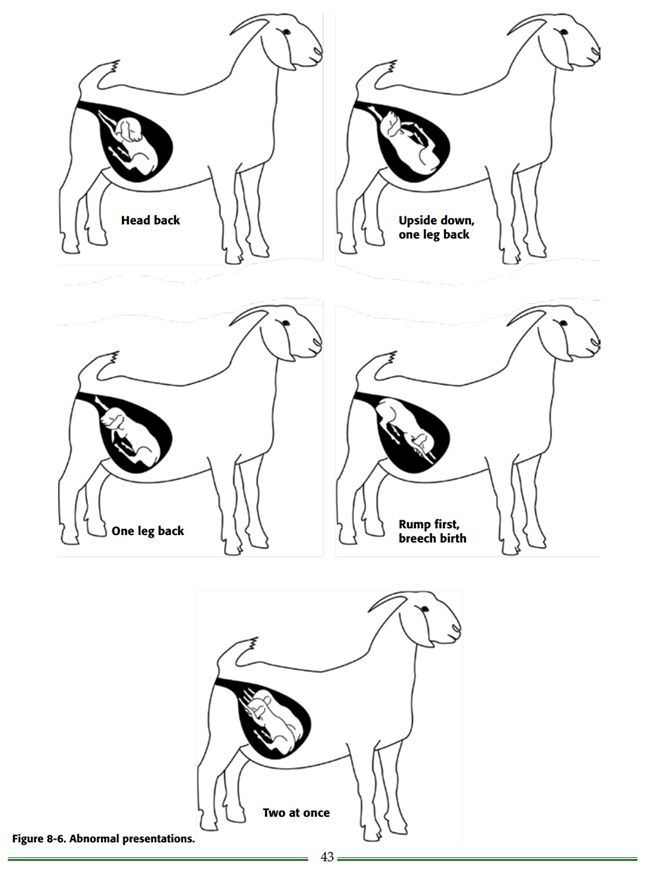
When To Lend Assistance
Once the doe enters stage two, a producer should watch her very closely. Some does can deliver their kids quickly and some may take up to 2 hours. Unless a producer is closely observing the doe, it may be difficult to determine how long she has been straining. It is recommended not to allow a doe to strain hard for more than 30 minutes. Many times the doe will stop straining and the uterus may contract around the kid.
How To Assist
Once it is determined that a doe needs assistance, the producer must choose to do it themselves or have it done by a veterinarian. If the kid is abnormally positioned that position must be corrected. This requires inserting the producer’s hand into the birth canal and uterus to reposition the kid.
Now the birth canal of a goat is relatively small when compared to the average hand of producers. This size difference could cause another source of frustration because if a producer is unable to get their hand into the birth canal, they will not be able to reposition the kid.
When To Stop
After attempting to reposition or pull the goat through the birth canal for 30 minutes and a producer has not been successful, it is time to get professional help. Although commercial goats may not be valuable enough to justify a large veterinary bill, producers should consider the potential value of future breeding when making this decision.
Nutrition of Newborn Kids
Colostrum is the first milk produced after parturition (the actual birthing process). Colostrum contains a high content of immunoglobulins (antibodies), vitamin A, minerals, fat and other sources of energy. Antibodies are proteins that help the goat kid fight off diseases.
The ability of kids to resist disease is greatly affected by the timing of colostrum intake and the quantity and quality of the colostrum ingested. Reports from cattle indicate that if left alone, 25 percent of the young do not nurse within eight hours and 10 to 25 percent do not get sufficient amounts of colostrum. Colostrum should be ingested or bottle-fed (in case of weak kids) as soon as kids have a suckling reflex
The producer must be certain all newborn kids get colostrum soon after birth (within the first hour after birth and certainly within the first six hours) because the percentage of antibodies found in colostrum decreases rapidly after parturition.
The antibodies in colostrum need to be consumed before the kids suck on dirty, pathogen-loaded parts of its mother or stall. In addition, the ability of the newborn kid to absorb antibodies also decreases rapidly 24 hours after birth. Newborn kids should ingest 10 percent of their body weight in colostrum during the first 24 hours of life for optimum immunity.
The extra colostrum produced by high-lactating does during the first 24 hours following kidding can be frozen for later use when needed. Only first milking from healthy animals should be frozen for later feeding, and the colostrum from older animals that have been on the premises for several years is typically higher in antibody content against endemic pathogens than is colostrum from first fresheners.
Ice cube trays are ideal containers: once frozen, cubed colostrum can be stored in larger containers and the trays used for another batch. Ice cubes are the perfect size for newborn kids, thus thawed colostrum is always fresh, and waste reduced to a minimum. Thawing colostrum either at room temperature or at a fairly low temperature is recommended. Colostrum should never be overcooked during the thawing process.
Revaccination against tetanus and enterotoxemia (over-eating disease) two to four weeks before the kidding date is commonly used to improve the protective value of the colostrum against these conditions.
When to Kid and When to Wean
Kidding season and weaning age depend on several management and marketing factors. However, kids born in very late winter and early spring, when grazed with their mothers on lush, high-quality small grains or cool-season forages, will grow faster and will be healthier than kids born during the heat of late spring and early summer, when forages mature and worm burdens increase. Letting the kids nurse and graze with their mothers for as long as the doe stays in good enough body condition so as not to impair the success of its next breeding season is a sound management practice that will ensure rapid growth of the goat kids.
Weaning is a very stressful period for kids and coccidia infestations generally show up at weaning. Frequent observation of weaned kids is very important. Kids showing signs of coccidia infestation should be treated immediately; otherwise they will dehydrate and die. Coccidia can damage the lining of the intestines, and if not treated properly, surviving kids may not grow to reach their normal size and production potential.
Body Condition Scoring (BCS)
As the breeding season approaches, producers should be concerned with the body condition of their breeding does. Goats should not be allowed to become too thin or too fat. Failure in reproduction, low twinning rates and low weaning rates can result if does are too thin. Overly fat does can suffer pregnancy toxemia, but fat does are rarely a problem.
Flushing, or increasing the level of feed offered to breeding does, can be accomplished by moving breeding does to a lush nutritious pasture three to four weeks prior to the introduction of the bucks. This cost-effective flushing method is underutilized in the southeast where forage is abundant. Another method is feeding one-half pound per day of a high-energy supplement. Corn is the grain of choice for flushing; whole cottonseed is another low cost, high energy supplement. The goal of supplements is to increase the intake and body weight. Breeding does should be grouped according to their BCS and be fed accordingly, first to improve their body condition, then to maintain it.
Selenium Deficiency and Supplementation
Selenium in soil is absorbed by growing plants that are eaten by foraging/browsing goats. Proper selenium levels are required for goats to breed, birth, lactate, urinate, and for proper muscle function. Symptoms of selenium deficiency (white muscle disease) are similar to those of Vitamin E deficiency. Presents as kids who are too weak to stand or suckle at birth, consistently cough, milk runs out of their nose after nursing, and those who develop pneumonia due to weakness of lung muscles. Symptoms in adult goats include abortions, stillbirths, retained placenta, or inability to conceive.
Dosages vary by region and should be discussed with a knowledgeable vet, but the following is a general outline of how many goat raisers supplement their goats to achieve adequate selenium levels:
Annually before breeding, goat producers in selenium-deficient areas give SQ injections of Bo-Se (Selenium with Vitamin E) to all adult goats, including breeding bucks. Bucks may be given Bo-Se injections twice a year. Pregnant does are again supplemented with Bo-Se 4-6 weeks before kidding. Selenium-deficient dams produce selenium-deficient kids. Kids are injected SQ with Bo-Se at birth, and again if not thriving.
General herd maintenance can also include providing a feed or mineral block with selenium included.
Table 8-1. Summary of reproductive characteristics in goats.
| Female | |
|---|---|
| Age of puberty | 7 to 10 months |
| Breeding Weight | 60 to 75% of adult weight |
| Length of estrous cycle | 18 to 22 days |
| Estrus duration | 12 to 36 hours |
| Signs of heat | Tail Wagging, Mounting, Bleating |
| Ovulation | 12 to 36 hours from onset of standing heat |
| Gestational length | 146 to 155 days |
| Breeding season | August to January |
| Seasonal anestrous | February to July |
| Buck effect on estrous | Positive |
| Male | |
|---|---|
| Age of puberty | 4 to 8 months |
| Breeding age | 8 to 10 months |
| Breeding season | All year |
| Breeding ratio | 1 buck: 20 to 30 does |
Source: Oklahoma State Extension - Kidding Chapter PDF
Goat Injections
Proper Administration of Injections
Administration of injectable medications is sometimes necessary in the routine management of goat herds. The following recommendations are guidelines for proper administration technique for each type of injection.Following these guidelines and using proper equipment and animal-handling methods will reduce stress on animals during treatment. Practicing proper sanitation will minimize introduction of bacteria into medication vials and/or the patient, thereby reducing injection reactions and abscesses. Dirty needles and syringes spread disease if used on multiple animals, so the use of dirty equipment should be avoided. Disposable needles are intended for one use only; more uses can contribute to abscesses at the injection site and can cause animal discomfort. Reusable stainless steel needles can be cleaned and disinfected between animals and used for multiple animals within a healthy herd. When sick animals exist within a herd, producers should not reuse needles. Reusable needles will become dull after six to 10 injections and need to be disposed of properly in a sharps container.
Selection of Needles
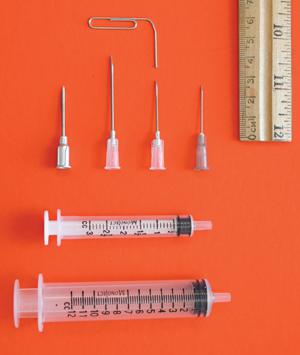
The proper technique of giving an injection starts with selecting the correct needle size to accommodate the type of injection. Needle size (gauge) selected should be proportional to the viscosity (thickness) of the medication to be given. The needle bore diameter increases as the needle gauge size decreases (e.g., 18G is larger than 20G). Most goat medications or vaccines can be given with 20 or 22G needles for thin, watery solutions or 18 to 20G needles for thicker medications.
The length of the needle is also relevant to the type of injection and route of administration. For injections under the skin (subcutaneous, Sub Q, or SQ), a ¾-inch needle is appropriate, especially for thin animals. For intramuscular (IM) injections or heavier animals, 1-inch or 1½-inch needles work well. Intravenous (in the vein, IV) is the most difficult injection technique and is usually administered by or under the direction of a veterinarian.
Recommended Needle Sizes and Lengths Used with Goats
| Age | Gauge | IM Injection (Needle Length) |
SC Injection (Needle Length) |
|---|---|---|---|
| Under 4 weeks old | 20 to 22 | ½ inch | ½ inch |
| 4 to 16 weeks | 20 to 22 | 5/8 to ¾ inch | ½ inch |
| 4 to 6 months | 20 to 22 | 1 inch | ½ inch |
| Over 6 months | 18 to 22 | 1 inch | ½ inch |
Subcutaneous Injections

Subcutaneous injections are normally administered by pulling up a pinch of skin to a "tent," inserting the needle into the base of the tent and parallel to the long axis of the animal's body. Be careful not to penetrate through to the other side and discharge the medication on the skin.
To give a SQ injection:
- Select or prepare a clean area of the skin. Common sites for subcutaneous injections are the extra skin under the foreleg area or behind the elbow, over the shoulder blade, in the flank area, and on the side of the neck
- Insert the needle with the bevel facing downward toward the ground; this will lessen the incidence of the drug leaking out of the injection site after the needle is withdrawn.
- Pull back on the syringe plunger and check the syringe hub to see if the needle has been inserted into a blood vessel. If blood is observed, remove or re-direct the needle and try again. If blood is not observed, slowly depress the syringe plunger until the contents of the syringe have been dispensed.
- Massage the site after withdrawing the needle.
- Do not give more than 5 cc (ml) of any medication at one site; divide the amount to be given into multiple injections of 5 cc or less.
IM Medications:
IM medications should never be given in muscles that correspond to valuable cuts of meat such as the leg or loin. Any problems with an injection in these areas may necessitate that significant portions of valuable meat be trimmed out and discarded from the carcass at processing. Instead, give IM injections in lower-quality meat cut areas such as the neck.
Injection sites are very important if you market your animals. Quality assurance programs are developed to educate youth (4-H and FFA) and producers on proper injection techniques. Legally, all goats are considered food animals throughout their entire life. Tissue irritation and reactions to injections can manifest as abscesses and scarring of meat and be detected at slaughter; these lesions compromise meat quality, consumer confidence, and producer profitability. Below are illustrations of improper and proper injection sites:
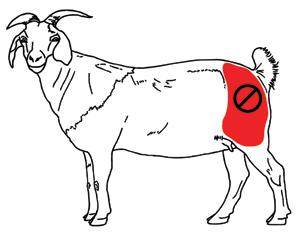
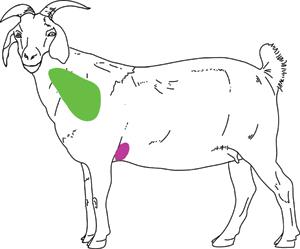
References:
Meat Goat Production Handbook, Langston University
Original Source: Quality Assurance – luresext.edu
